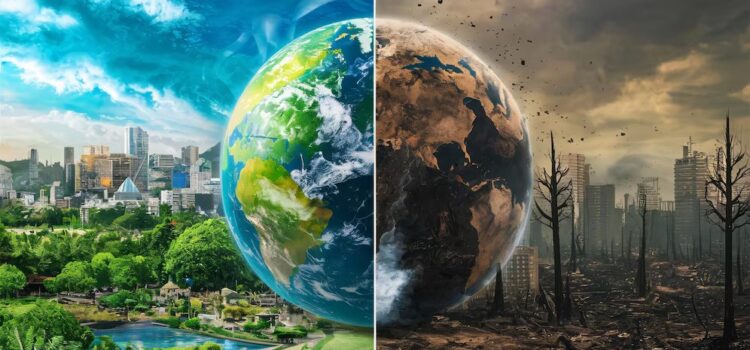The Earth, once a vibrant blue marble swirling in the vast cosmos, now walks a tightrope. Climate change, the ever-tightening grip of a warming planet, casts a long shadow. Its effects, a chilling symphony of rising seas, erratic weather, and ecosystem collapse, threaten the very foundations of life as we know it. Yet, amidst the looming crisis, a chorus of hope rises – the determined fight for sustainability. This article explores the ongoing impact of climate change and the valiant efforts to cultivate a more sustainable future.
The Escalating Threat: Climate Change’s Bite
The scientific consensus is clear: human activity, primarily the burning of fossil fuels, has disrupted the delicate balance of Earth’s atmosphere. This translates to a relentless rise in global temperatures, a phenomenon known as global warming. The consequences are far-reaching and often catastrophic.
Rising Seas, Drowning Coastlines: Our planet’s frozen giants – glaciers and ice sheets – are melting at an alarming rate. This meltwater contributes to rising sea levels, threatening coastal communities worldwide. Entire islands face the prospect of disappearing beneath the waves, displacing millions and jeopardising vital ecosystems.
Weather Gone Wild: The warming atmosphere disrupts weather patterns, leading to more frequent and intense extremes. Heatwaves scorch landscapes, while powerful storms unleash their fury, leaving destruction in their wake. Floods become more common, displacing populations and crippling agricultural production. Droughts grip regions, jeopardizing food security and straining water resources.
Ecosystems in Peril: Climate change doesn’t play favorites. From coral reefs bleaching and dying to forests succumbing to wildfires, the delicate webs of life are unraveling. Migratory patterns are disrupted, and some species struggle to adapt to the rapid climate change. The very foundation of the natural world, upon which human well-being depends, is under siege.
The human cost of climate change is already staggering. Millions are affected by extreme weather events, with vulnerable communities bearing the brunt of the impact. Food security is jeopardized, leading to malnutrition and hunger. Rising sea levels threaten coastal communities, forcing mass displacement. Climate change acts as a threat multiplier, exacerbating existing inequalities and creating new ones.
The Urgency of the Situation
The planet is facing an unprecedented challenge – the relentless march of climate change. From raging wildfires to devastating droughts, the impacts of global warming are becoming increasingly undeniable. Scientists have sounded the alarm, issuing dire warnings about the consequences of our continued reliance on fossil fuels and unsustainable practices. The time for action is now, as the future of our world hangs in the balance.
The Alarming Trends
The data paints a sobering picture. Global temperatures have risen by over 1°C since the pre-industrial era, and if left unchecked, could reach catastrophic levels by the end of the century. Sea levels are steadily rising, threatening coastal communities and ecosystems. Extreme weather events, such as hurricanes, floods, and heat waves, are becoming more frequent and intense, wreaking havoc on communities and economies worldwide.
The Consequences of Inaction
The consequences of our collective inaction are far-reaching and devastating. Millions of people face the prospect of displacement due to rising sea levels and environmental degradation. Food and water security are under threat, as droughts and crop failures disrupt agricultural systems. Biodiversity is plummeting at an alarming rate, with entire species facing extinction. The health impacts are equally dire, with air pollution, heat-related illnesses, and the spread of vector-borne diseases becoming increasingly prevalent.
Seeding Sustainability: Cultivating a Greener Future

In the face of this daunting challenge, humanity isn’t without hope. A global movement for sustainability is taking root, driven by a collective desire to protect our planet for generations to come. This movement encompasses a diverse range of initiatives, from individual actions to international agreements.
Renewable Energy Revolutionizing
One of the most promising areas of progress is the rapid growth of renewable energy technologies. Solar, wind, and geothermal power are becoming increasingly cost-effective and widely adopted, transforming the global energy landscape. Many countries have set ambitious targets to phase out fossil fuels and achieve net-zero emissions by mid-century, paving the way for a more sustainable future.
Sustainable Transportation Solutions
The transportation sector, a major contributor to greenhouse gas emissions, is also undergoing a significant transformation. Electric vehicles are gaining popularity, with advancements in battery technology and the expansion of charging infrastructure. Governments are implementing policies to incentivize the adoption of clean transportation, such as vehicle emissions standards and investments in public transit and cycling infrastructure.
The Road Ahead: Collaboration and Transformation
The fight against climate change and the pursuit of sustainability demand a collective effort. Here are some key areas where progress is crucial:
International Cooperation: Global challenges require global solutions. International agreements like the Paris Agreement provide a framework for countries to work together in reducing emissions and mitigating climate change. Strengthening these agreements and ensuring their effective implementation is vital.
Technological Innovation: Continued investment in research and development is critical for accelerating the transition to clean energy technologies and sustainable practices. Innovation holds the key to unlocking new solutions and overcoming current limitations.
Cities Get a Helping Hand: The Rise of the “Liquid Tree”
The “Liquid Tree”, also known as Liquid3, is not an actual tree but a technology designed for urban environments. In the fight against air pollution, planting trees in forests is a well-known method adopted by both companies and governments to lower atmospheric CO2 levels. However, in heavily populated cities, where pollution is concentrated, there is little room for planting even the smallest of greenery. Serbian scientists from the University of Belgrade have introduced a revolutionary solution to the problem of air pollution in densely populated urban areas.
This is a device that converts carbon dioxide into oxygen just as plants do. An alternative to planting trees. You can install this tree in 1 day rather than waiting 20 years. It also serves as a bench, complete with mobile phone chargers, and features a solar panel for lighting at night. The goal of LIQUID TREE is not to replace forests, but to use this system to fill those urban pockets where there is no space for planting trees. It’s a photobioreactor that uses microalgae to capture air pollutants and CO2, and release clean oxygen, mimicking the function of trees in areas where planting trees is difficult.
One Liquid3 unit is said to be as effective as two mature trees. The LIQUID 3 ideology aims to promote and expand the use of microalgae for various purposes, such as wastewater treatment, composting, biomass and biofuel production, and air purification from exhaust gases from factories.

“The fact is that no species has ever had such wholesale control over everything on Earth, living or dead, as we now have. That lays upon us, whether we like it or not, an awesome responsibility. In our hands now lies not only our own future, but that of all other living creatures with whom we share the Earth.”
– renowned naturalist Sir David Attenborough in the documentary series, Life On Earth.

By Saurabh
Superb article with great insight…